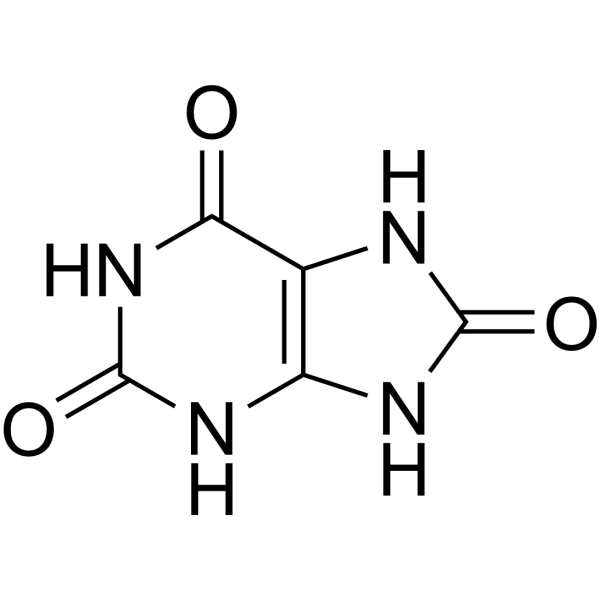
| 规格 | 价格 | 库存 | 数量 |
|---|---|---|---|
| 500mg |
|
||
| 1g |
|
||
| Other Sizes |
| 体外研究 (In Vitro) |
尿酸(400 μM;48 小时)可保护 Caco-2 细胞免受吲哚美辛诱导的脂质过氧化的影响 [2]。与单独用吲哚美辛处理的细胞相比,用吲哚美辛和尿酸(200 μM IND 加 400 μM UA;24 小时)共同处理细胞可显着降低 ROS 水平。同时用吲哚美辛和尿酸(200 μM IND 加 400 μM UA;24 小时)处理的 Caco-2 细胞中的细胞活力高于单独用吲哚美辛处理的细胞。尿酸通过其抗氧化活性对吲哚美辛诱导的肠道细胞改变具有保护作用[2]。
|
|---|---|
| 动物实验 |
Animal/Disease Models: 8weeks old male C57BL/6J mice [2]
Doses: 250 mg/kg body weight Route of Administration: Po Experimental Results: When mice are given indomethacin at the same time, uric acid can be used for animal modeling to construct a hypertension model. . After oral administration of uric acid, the ulcer area was Dramatically diminished in a uric acid dose-dependent manner. |
| 药代性质 (ADME/PK) |
Absorption, Distribution and Excretion
Uric acid is eliminated by the kidneys. Metabolism / Metabolites In higher primates and humans, the enzyme, uricase, is absent, and thus uric acid is not further metabolized and is excreted. In all other mammals, uric acid is metabolized by uricase to allantoin, which is then excreted. |
| 参考文献 | |
| 其他信息 |
7,9-dihydro-1H-purine-2,6,8(3H)-trione is an oxopurine in which the purine ring is substituted by oxo groups at positions 2, 6, and 8. It has a role as a human metabolite, an Escherichia coli metabolite and a mouse metabolite. It is a tautomer of a 2,6-dihydroxy-7,9-dihydro-8H-purin-8-one, a 9H-purine-2,6,8-triol, a 7H-purine-2,6,8-triol, a 1H-purine-2,6,8-triol and a 5,7-dihydro-1H-purine-2,6,8(9H)-trione.
Uric acid is the last product of purine metabolism in humans. The formation of uric acid is through the enzyme xanthine oxidase, which oxidizes oxypurines. Normally a small amount of uric acid is present in the body, but when there is an excess amount in the blood, called hyperuricemia, this can lead to gout and formation of kidney stones. As a therapeutic agent, it is known that uric acid is increased in response to oxidative stress, and as such, uric acid acts as an antioxidant. At present (August 2013), there is no approved formulation or indication for uric acid. In one country, Spain, uric acid is an investigational drug in a phase 3 trial studying its effects as an adjunct to alteplase in acute ischemic stroke. Uric acid is a metabolite found in or produced by Escherichia coli (strain K12, MG1655). Uric acid has been reported in Drosophila melanogaster, Punica granatum, and other organisms with data available. Uric Acid is a white tasteless odorless crystalline product of protein metabolism, found in the blood and urine, as well as trace amounts found in the various organs of the body. It can build up and form stones or crystals in various disease states. Uric acid is a metabolite found in or produced by Saccharomyces cerevisiae. An oxidation product, via XANTHINE OXIDASE, of oxypurines such as XANTHINE and HYPOXANTHINE. It is the final oxidation product of purine catabolism in humans and primates, whereas in most other mammals URATE OXIDASE further oxidizes it to ALLANTOIN. See also: ... View More ... Drug Indication At present (August 2013), there is no approved indication for uric acid. The potential therapeutic use for uric acid is as an adjunct in acute ischemic stroke. Mechanism of Action The exact mechanism of action for uric acid's antioxidant effects have not yet been elucidated. |
| 分子式 |
C5H4N4O3
|
|---|---|
| 分子量 |
168.1103
|
| 精确质量 |
168.028
|
| CAS号 |
69-93-2
|
| 相关CAS号 |
Uric acid sodium;1198-77-2;Uric acid-13C,15N3;2421217-23-2;Uric acid-15N2;62948-75-8;Uric acid-13C3;2832998-22-6
|
| PubChem CID |
1175
|
| 外观&性状 |
White to off-white solid powder
|
| 密度 |
1.9±0.1 g/cm3
|
| 沸点 |
863ºC at 760 mmHg
|
| 熔点 |
>300 °C(lit.)
|
| 闪点 |
475.7ºC
|
| 折射率 |
1.721
|
| LogP |
-1.08
|
| tPSA |
114.37
|
| 氢键供体(HBD)数目 |
4
|
| 氢键受体(HBA)数目 |
3
|
| 可旋转键数目(RBC) |
0
|
| 重原子数目 |
12
|
| 分子复杂度/Complexity |
332
|
| 定义原子立体中心数目 |
0
|
| HS Tariff Code |
2934.99.9001
|
| 存储方式 |
Powder -20°C 3 years 4°C 2 years In solvent -80°C 6 months -20°C 1 month |
| 运输条件 |
Room temperature (This product is stable at ambient temperature for a few days during ordinary shipping and time spent in Customs)
|
| 溶解度 (体外实验) |
1M NaOH : 8.33 mg/mL (~49.55 mM)
H2O : ~6.25 mg/mL (~37.18 mM) DMSO :< 1 mg/mL |
|---|---|
| 溶解度 (体内实验) |
配方 1 中的溶解度: 10 mg/mL (59.48 mM) in 0.5% CMC-Na/saline water (这些助溶剂从左到右依次添加,逐一添加), 悬浮液;超声助溶。
*生理盐水的制备:将 0.9 g 氯化钠溶解在 100 mL ddH₂O中,得到澄清溶液。 请根据您的实验动物和给药方式选择适当的溶解配方/方案: 1、请先配制澄清的储备液(如:用DMSO配置50 或 100 mg/mL母液(储备液)); 2、取适量母液,按从左到右的顺序依次添加助溶剂,澄清后再加入下一助溶剂。以 下列配方为例说明 (注意此配方只用于说明,并不一定代表此产品 的实际溶解配方): 10% DMSO → 40% PEG300 → 5% Tween-80 → 45% ddH2O (或 saline); 假设最终工作液的体积为 1 mL, 浓度为5 mg/mL: 取 100 μL 50 mg/mL 的澄清 DMSO 储备液加到 400 μL PEG300 中,混合均匀/澄清;向上述体系中加入50 μL Tween-80,混合均匀/澄清;然后继续加入450 μL ddH2O (或 saline)定容至 1 mL; 3、溶剂前显示的百分比是指该溶剂在最终溶液/工作液中的体积所占比例; 4、 如产品在配制过程中出现沉淀/析出,可通过加热(≤50℃)或超声的方式助溶; 5、为保证最佳实验结果,工作液请现配现用! 6、如不确定怎么将母液配置成体内动物实验的工作液,请查看说明书或联系我们; 7、 以上所有助溶剂都可在 Invivochem.cn网站购买。 |
| 制备储备液 | 1 mg | 5 mg | 10 mg | |
| 1 mM | 5.9485 mL | 29.7424 mL | 59.4849 mL | |
| 5 mM | 1.1897 mL | 5.9485 mL | 11.8970 mL | |
| 10 mM | 0.5948 mL | 2.9742 mL | 5.9485 mL |
1、根据实验需要选择合适的溶剂配制储备液 (母液):对于大多数产品,InvivoChem推荐用DMSO配置母液 (比如:5、10、20mM或者10、20、50 mg/mL浓度),个别水溶性高的产品可直接溶于水。产品在DMSO 、水或其他溶剂中的具体溶解度详见上”溶解度 (体外)”部分;
2、如果您找不到您想要的溶解度信息,或者很难将产品溶解在溶液中,请联系我们;
3、建议使用下列计算器进行相关计算(摩尔浓度计算器、稀释计算器、分子量计算器、重组计算器等);
4、母液配好之后,将其分装到常规用量,并储存在-20°C或-80°C,尽量减少反复冻融循环。
计算结果:
工作液浓度: mg/mL;
DMSO母液配制方法: mg 药物溶于 μL DMSO溶液(母液浓度 mg/mL)。如该浓度超过该批次药物DMSO溶解度,请首先与我们联系。
体内配方配制方法:取 μL DMSO母液,加入 μL PEG300,混匀澄清后加入μL Tween 80,混匀澄清后加入 μL ddH2O,混匀澄清。
(1) 请确保溶液澄清之后,再加入下一种溶剂 (助溶剂) 。可利用涡旋、超声或水浴加热等方法助溶;
(2) 一定要按顺序加入溶剂 (助溶剂) 。